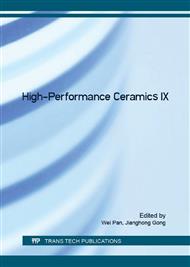p.489
p.494
p.498
p.506
p.510
p.515
p.521
p.526
p.530
Microstructure and Mechanical Properties of ZrB2/h-BN Multiphase Ceramics by Low-Temperature Reactive Sintering
Abstract:
In the present paper, the ZrB2/h-BN multiphase ceramics were fabricated by SPS (spark plasma sintering) technology at lower sintering temperature using h-BN, ZrO2, AlN and Si as raw materials and B2O3 as a sintering aid. The phase constitution and microstructure of specimens were analyzed by XRD and SEM. Moreover, the effects of different sintering pressures on the densification, microstructure and mechanical properties of ZrB2/h-BN multiphase ceramics were also systematically investigated. The results show that the ZrB2 was obtained through solid phase reaction at different sintering pressures, and increasing sintering pressure could accelerate the formation of ZrB2 phase. As the sintering pressure increasing, the fracture strength and toughness of the sintered samples had a similar increasing tendency as the relative density. The better comprehensive properties were obtained at given sintering pressure of 50 MPa, and the relative density, fracture strength and toughness reached about 93.4%, 321 MPa and 3.3 MPa·m1/2, respectively. The SEM analysis shows that the h-BN grains were fine and uniform, and the effect of sintering pressure on grain size was inconspicuous. The distribution of grain is random cross array, and the fracture texture was more obvious with the increase of sintering pressure. The fracture mode of sintered samples remained intergranular fracture mechanism as sintering pressure changed, and the grain refinement, grain pullout and crack deflection helped to increase the mechanical properties.
Info:
Periodical:
Pages:
510-514
Citation:
Online since:
July 2016
Authors:
Price:
Сopyright:
© 2016 Trans Tech Publications Ltd. All Rights Reserved
Share:
Citation:


